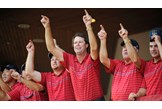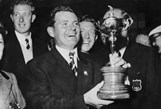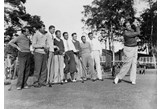7 things you didn’t know about the Ryder Cup
Published: Last updated:
The Ryder Cup is firmly in golfing folklore after nearly a century of cheers, tears, comebacks and chokes. But what about events away from the public gaze in the last 87 years? We spoke to Ross Biddiscombe, author of the new book ‘Ryder Cup Revealed: Tales of the Unexpected’, to uncover seven things you (probably) didn’t know about golf’s most famous team contest…
1 The USA team stayed in railway carriages during the first match
Pro golf was still finding its feet on both sides of the Atlantic in 1921. The British PGA was 20 years old but its progress had been ravaged by World War I and there were only a few hundred pros. The PGA of America only started in 1916, so to organise an ‘International Challenge Match’ at this time was some feat and, unsurprisingly, not completed without teething troubles. Gleneagles hosted the 1921 contest but the opening of the hotel was three years away. The best temporary accommodation was in nearby railway carriages. The players had to fetch and carry water for washing, adding to the pioneer feeling of this first attempt at a GB-US contest for the pros.
2 The British team was green and the American public disinterested ahead of the first Ryder Cup
The inaugural Ryder Cup, staged on American soil in 1927, was hardly a headline affair. Firstly, the British team undertook a journey across the Atlantic and then a long train ride from New York to Massachusetts. The experience left some players in less than fine fettle for the match, which was overshadowed by the legendary solo trans-Atlantic flight of Charles Lindbergh just a few days before the match began. It was hardly an auspicious start.
3 The Prince of Wales helped Britain to victory in 1933
The great Walter Hagen’s ego may have won him many matches as he overpowered opponents with his personality, but it also lost him a Ryder Cup. The self-styled ‘Sir’ Walter led a strong American team to Southport & Ainsdale in 1933 and they were poised for a famous victory when the last match reached the 18th green. English journeyman Syd Easterbrook was all-square with one of America’s exciting new talents, Denny Shute. The crowd hushed as both men reached for their putters after three shots. Easterbrook’s par attempt came up a couple of feet short so Shute had a putt to win the Cup. Rules state that only a captain can advise a player in a singles match and any other skipper would have been on Shute’s shoulder. But Hagen was in the clubhouse chit-chatting with special guest, the Prince of Wales, and, rather than leave his majesty, the American watched as Shute three-putted to hand victory to the home team.
4 A cancelled lunch helped Britain end a run of seven straight defeats
The British PGA was always on the lookout for a financial mentor in the post-World War II period. Sheffield industrialist Sir Stuart Goodwin had no idea that he would fulfil that role until a cancelled lunch meeting led him to go and watch pros at Lindrick Golf Club. He enjoyed the experience so much that he put £10,000 into the 1957 match at the same club. When Dai Rees’ team won for the first time in over 20 years they had Goodwin to thank for financing the contest.
5 George W Bush caused the wild celebrations at Brookline in 1999
Who was to blame for the Battle of Brookline and over-the-top behaviour of American players, fans and even their wives? Well, the then Governor of Texas, George W Bush (the future 43rd American president), read a letter to the American team on the eve of the contest’s final day written by a soldier before his death at the battle of the Alamo in 1836. There were tears in the US team room and, the next day, wild scenes on the fairways and greens as Ben Crenshaw’s team won.
6 The US Navy inspired Paul Azinger’s USA team to victory in 2008
Paul Azinger put his teams into groups of four during practice in the style of US Navy SEALs whose lives hinged on the trust they developed in each other during dangerous operations. Azinger’s pairings came from those so-called ‘pods’ as the US won without Tiger Woods.
7 There’s a Ryder Cup… in Zimbabwe
In 1933, Samuel Ryder’s daughter Marjorie asked her father to send a trophy to the golf-playing white Rhodesian farming community where she lived. Ryder ordered a silver, near-replica version of the original Ryder Cup to be made, and, before he died two years later, allowed his daughter to name the trophy ‘The Ryder Cup’. For decades this trophy was unknown in Britain or America and the Rhodesians (later the Zimbabweans) played for their own Ryder Cup. The trophy was lost for a while, then not played for at all as the political situation grew darker. But this year the newly-titled Zimbabwe Ryder Cup has been revived. It is now a celebration of amateur golf as a four-team tournament with three local clubs taking on a specially-invited international team the week before Europe hosts America at Gleneagles.
Register for Ryder Cup Fantasy Golf today!
 ‘Ryder Cup Revealed: Tales of the Unexpected’ by Ross Biddiscombe is on sale at all good book stores and online via Amazon.co.uk or GolfontheEdge.co.uk
‘Ryder Cup Revealed: Tales of the Unexpected’ by Ross Biddiscombe is on sale at all good book stores and online via Amazon.co.uk or GolfontheEdge.co.uk



